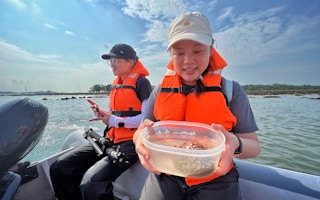As the full moon shines on the seashore at the southern end of Singapore, a group of researchers are scavenging for giant clams, cowries, fiddler crabs and sea cucumbers — intertidal marine creatures that could aid them in breeding studies or help them understand how microplastics are affecting the underwater ecosystem. The surroundings are dark and they are only aided by dim lights from their torches.
To continue reading, subscribe to Eco‑Business.
There's something for everyone. We offer a range of subscription plans.
- Access our stories and receive our Insights Weekly newsletter with the free EB Member plan.
- Unlock unlimited access to our content and archive with EB Circle.
- Publish your content with EB Premium.
For Dr Neo Mei Lin, who is part of the research group, waking up before daybreak for fieldwork is a routine that she is used to. Her career as a marine ecologist started in 2006 when she embarked on a research project to investigate the iconic giant clam’s larval ecology, while pursuing her undergraduate studies in environmental biology.
This passion to save the endangered giant clams eventually led to a major restocking programme in Singapore between 2011 and 2018, with the aim of breeding and rearing baby clams to repopulate the island’s reefs.

(From left, clockwise) The boring giant clam (Tridacna crocea), so-named because it bores into coral rubble where it lives for its adult life, can grow up to 15 cm long; the fluted giant clam (Tridacna squamosa) is presently the largest extant species inhabiting the reefs of the southern shores in Singapore; the Arabian cowrie (Mauritia arabica) is a type of sea snail that can be found living in the rocky intertidal seashores of Singapore; the Halloween flatworm (Pseudobiceros sp.) is vibrantly coloured with its orange and white ruffled margins. Image: Neo Mei Lin / Tropical Marine Science Institute
Now a mother of two girls and a project leader for work carried out at the St John’s Island National Marine Laboratory, Neo has additional “duties” — attending meetings with potential funders, writing grant proposals, mentoring younger researchers, as well as making sure her daughters are taken care of — to juggle.
“My contribution to marine conservation has slightly changed, as I play a larger role in contributing expertise and opinions towards agency-stakeholder engagements and giving talks to various organisations,” she said of her role as a science communicator.
Neo’s research now also focuses on marine litter, a scourge of the oceans and a problem that needs urgent solving. As part of her work, she reviews the status of marine plastic research and policy in the Asean region, and has most recently worked on Singapore’s National Action Strategy on Marine Litter, by invitation from the Ministry of Sustainability and Environment to provide research support to the initiative.
The strategy outlines six strategic focus areas tailored to Singapore’s context and demonstrates the city-state’s commitment to addressing marine litter domestically and internationally. Neo said that it is an important step taken by the Singapore government as it shows that marine litter is a recognised marine issue.
“
Southeast Asia is a hotspot for marine biodiversity and ecosystems, but unfortunately also a region that is generating relatively large amounts of plastic waste that ends up in the oceans.
In March this year, the United Nations Environment Assembly agreed to adopt a resolution setting up the path to a legally binding global treaty to end plastic pollution. Neo welcomes the initiative and said that this sets a precedent for UN member states to accept that plastic pollution is dire and that it needs to be urgently addressed.
“Southeast Asia is a hotspot for marine biodiversity and ecosystems, but unfortunately also a region that is generating relatively large amounts of plastic waste that ends up in the oceans,” said Neo. There has been supporting research in Southeast Asia demonstrating the impacts of marine litter to biodiversity, for example entanglement, asphyxiation and starvation, and Neo suggests that waste management facilities need to be developed, to stem the flow of plastics into the oceans.
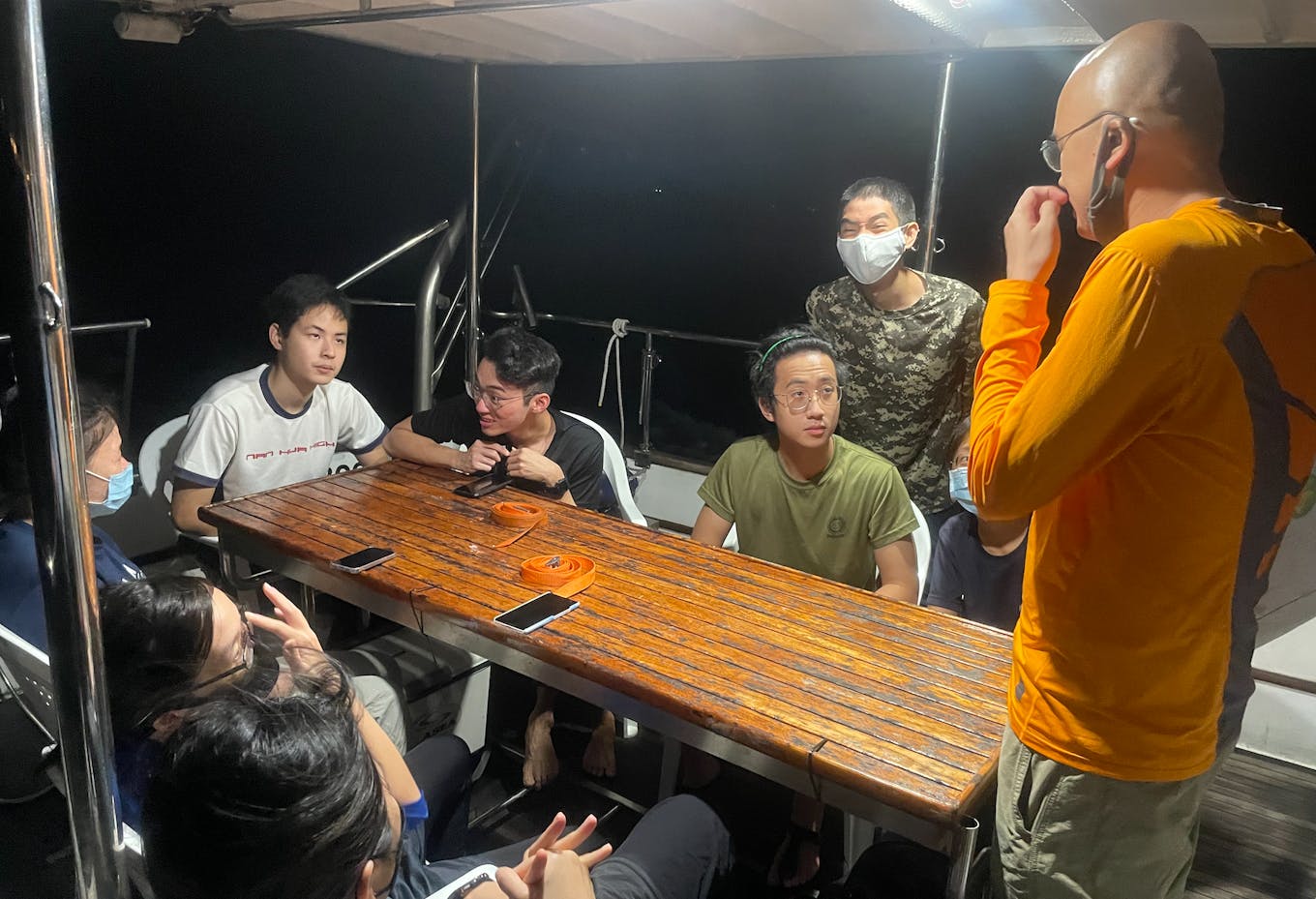
Pre-dawn fieldwork briefing led by the senior researchers for the young students on what to expect in the field and goals of the trip. Image: Neo Mei Lin / Tropical Marine Science Institute
Here is how a (busy) work day unfolds for Neo:
3.30am: Today, I have a super early morning call. I need to prepare for pre-dawn fieldwork at a seashore located in the south of Singapore. I silence my alarm and creep around the room to change into my field outfit that usually consists of a long-sleeved dri-fit top and a pair of long pants. I head to the kitchen to make myself a cup of soy protein drink that serves as my quick breakfast, while making a bottle of formula milk for my youngest child who is now seven months old. I begin my routine of feeding her milk, changing her diaper, and putting her back to sleep, before rushing out of my house stealthily (to avoid waking her up!) to catch my ride to the marina.
4.45am: I barely arrive on time to meet my colleagues at the marina to catch our boat. We take attendance and make our way to board the boat. Despite the fact that it is so early in the morning, everyone looks excited and ready for the fieldwork. The team today is made up of researchers and students from various research projects, and everyone is having a casual chat, making their self-introductions and sharing more about what they are working on. A large part of my research is supported with the help and assistance of student interns, whom we train to conduct research independently and efficiently. Some of them contribute significantly towards our research by running experiments and collecting data that eventually go into scientific publications.
5.30am: As we inch closer to our field site, my colleague, Dr Nicholas Yap, a sea anemone expert, gives the overall briefing on field safety and highlights the goals of today’s fieldwork. In a single fieldtrip, we may be looking for different organisms to support various research projects. Today, we are seeking out giant clams, cowries, fiddler crabs, and sea cucumbers. The giant clam and cowrie are for mariculture breeding studies, while the fiddler crabs and sea cucumbers are for microplastic studies. Much of the marine science research I do requires the close examination of marine organisms in the field and in the laboratories, hence our regular collection of organisms from the field allows us to study and observe them. In order to ensure that our collection does not impact species populations, we limit the number of individuals we collect each time and diversify our collection sites. After the experiments end, we return the organisms. After the briefing, we don our life jackets and take the rubber dinghy to reach and land amphibiously on the shore. Once we land, we start to spread ourselves out and carry on with the work.
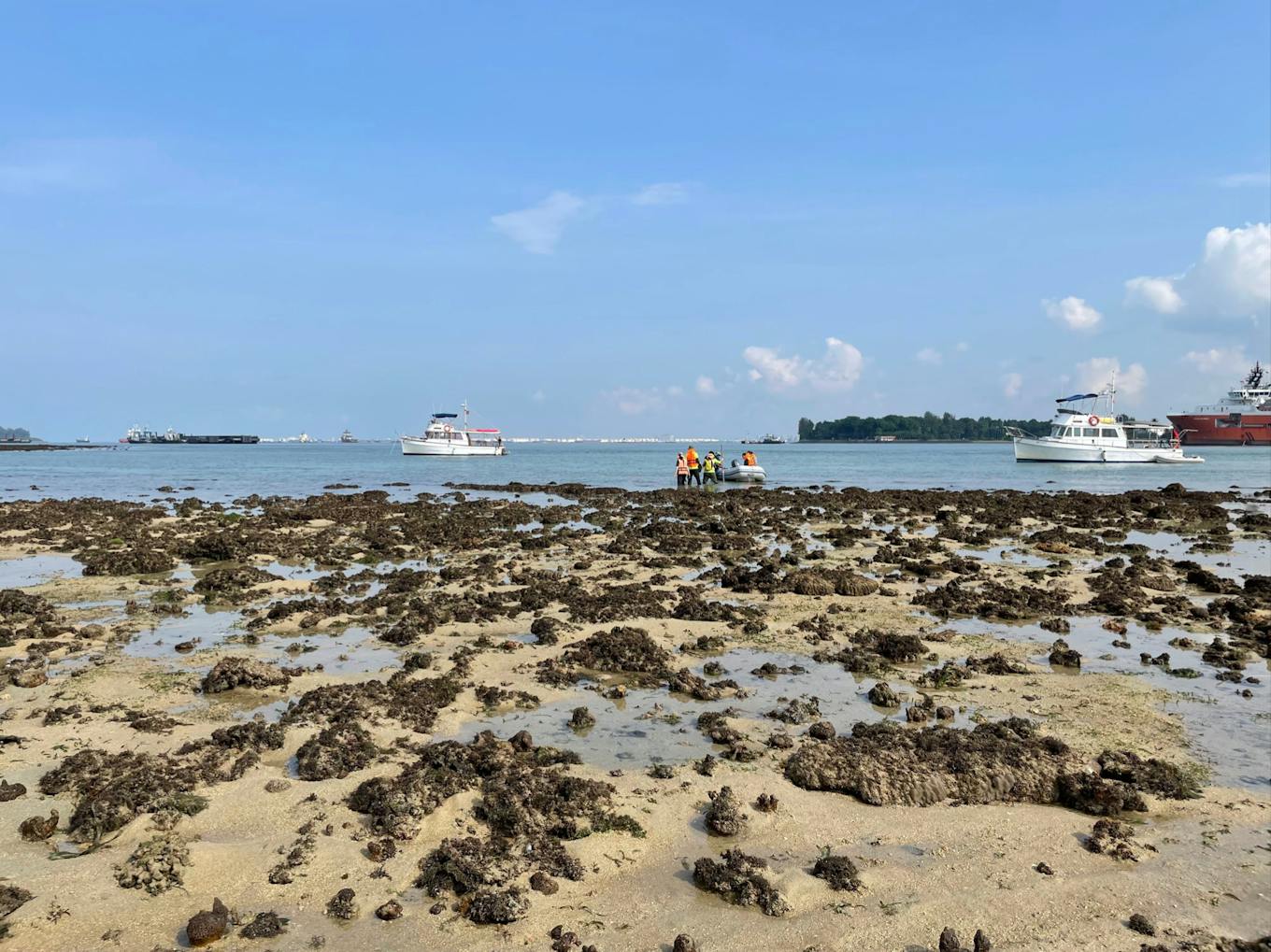
As the sun rises, it marks the end of the field work. Researchers depart from the field site via the rubber dinghy to board the boats. Image: Neo Mei Lin / Tropical Marine Science Institute
9.30am: The sun has risen and the tides are coming in. It is time to depart from the seashore before we get stranded due to rising waters. Once the team boards the boat, we leave the field site and are en route to St John’s Island National Marine Laboratory (SJINML) to start our day in the ‘office’. Along with the others, I catch up on some sleep as the boat zooms towards our destination. On other days, I would be sending my daughters to childcare instead.
10.30am: We disembark the boat and make our regular trek up the hill towards the SJINML. After dropping off my bags in the office, I wash up my wet booties and change out of my wet clothes. My team of researchers will settle the various collected organisms into their respective containments. Organisms meant for mariculture studies will be cleaned before they are introduced into the aquaria tanks for observation, while organisms meant for microplastic studies will be preserved, labelled and stored for further lab processing. My routine is to head back into my office to begin my desk work that includes checking emails, endorsing invoices for finance payments, attending to calls and meetings, and amid all these, find the time for breakfast. As a project leader, I find myself spending less time in the field and doing the research itself because of other responsibilities such as managing projects, attending meetings with potential funders, and writing grant proposals. My contribution to marine conservation has changed slightly, as I play a larger role in contributing expertise and opinions towards agency-stakeholder engagements and giving talks to various organisations.
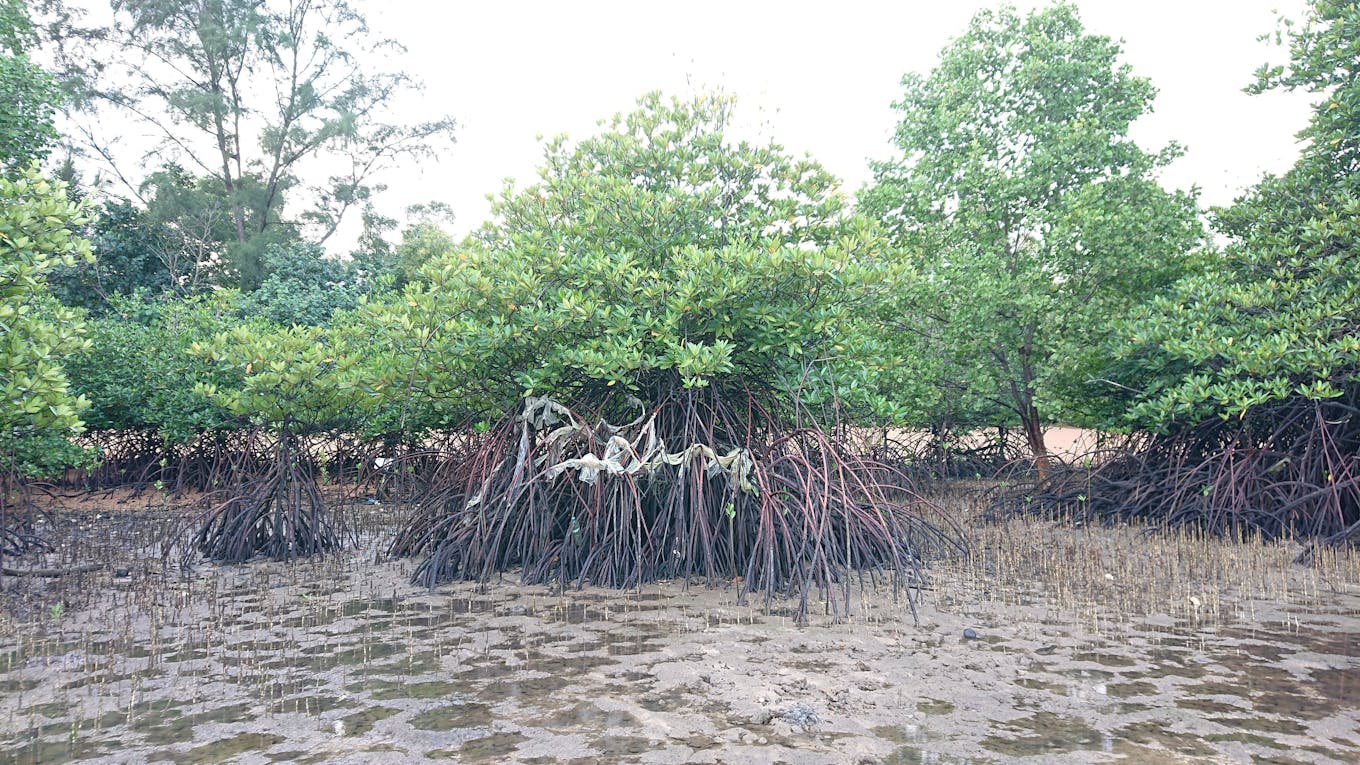
Mangrove forests are shown to be effective in trapping marine litter in their aerial root systems, making it one of the hotspots for plastic debris. Image: Neo Mei Lin / Tropical Marine Science Institute
12.00pm: I take my lunch in the common pantry area, where I will find many of my colleagues taking their lunch breaks. This is the time I spend chatting and catching up with my colleagues on their projects and personal lives. As someone working in marine conservation, I often engage in conversations with my colleagues to find out what their research is about and to learn of their findings, with the aim of broadening my perspective of the relevance of their work, and how it fits in the bigger picture of marine conservation.
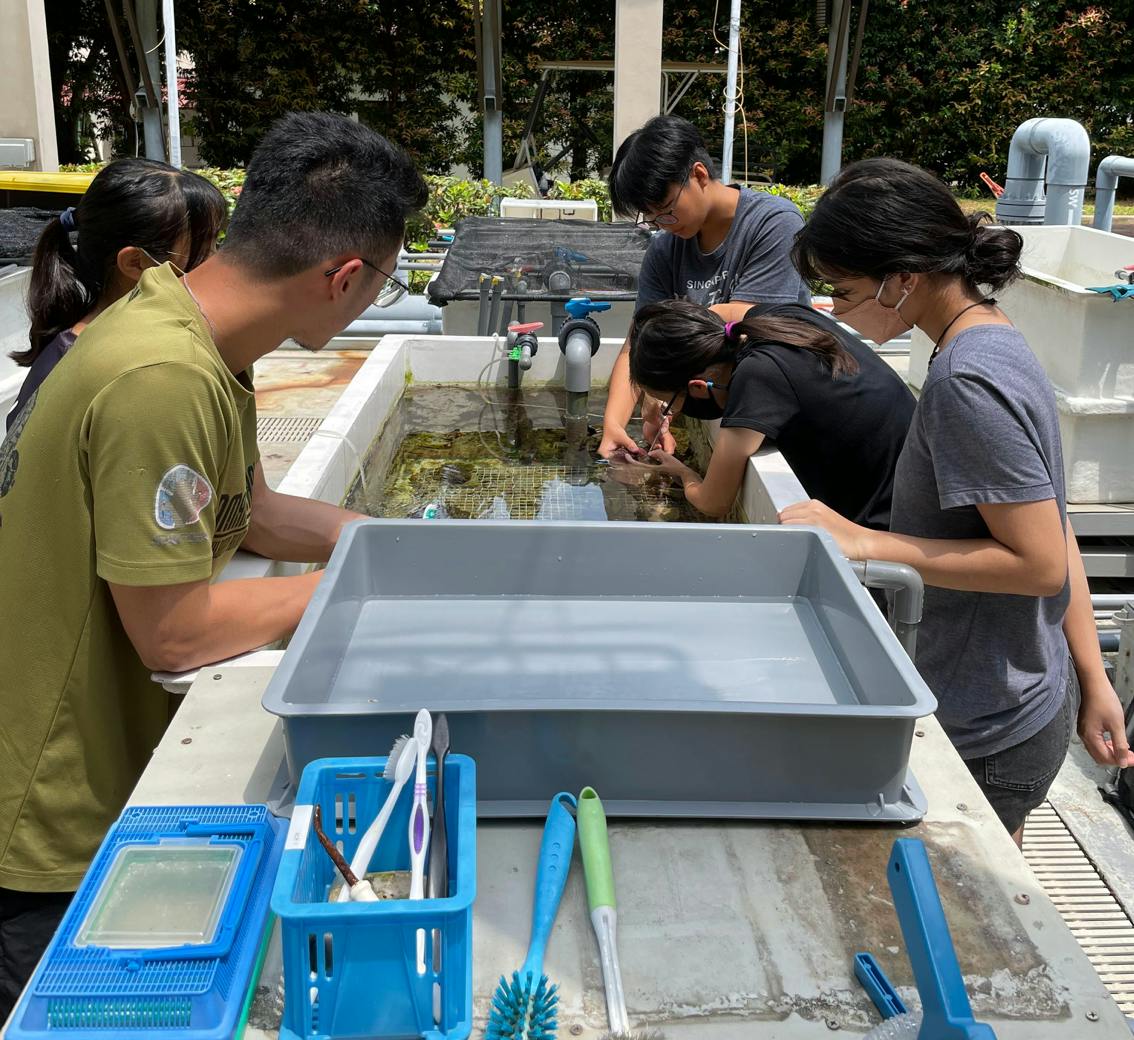
Before a giant clam spawning attempt, the team would select individuals for the spawning, followed by cleaning their shells and putting them into the spawning tanks. Image: Neo Mei Lin / Tropical Marine Science Institute
1.00pm: Typically I will spend the rest of the work day checking on the research progress of my projects by speaking to members of my team in meetings and discussions, or checking on the lab work for microplastics extraction from samples collected in Singapore. The latter research is part of a larger project framework that seeks to investigate how microbial communities found on marine plastics could be helpful towards managing plastics in the oceans. Specifically, our work focuses on producing baselines for macro- and microplastic pollution in the coastal environment that can be used to inform national policy and strategy. Because of my recent work in marine plastics, I was invited by the Ministry of Sustainability and Environment (MSE) to serve as an academic stakeholder to provide input for the recently launched National Action Strategy on Marine Litter (NASML). It outlines six strategic focus areas tailored to Singapore’s local context and demonstrates Singapore’s commitment to addressing marine litter domestically and internationally. This is an important step taken by the government as it shows that marine litter is a recognised marine issue and the commitment to stem the problems.

The giant clam is induced to spawn its eggs or sperm via an injection of serotonin (a type of neurotransmitter) into its sex gonad. After a few minutes, the clam can be observed to release white clouds of sperm into the tank. The release of eggs usually comes after sperm release, where the former will appear as small white dots. The sperm and eggs are collected separately, fertilised for further observations of its larval developmental cycle. Image: Neo Mei Lin / Tropical Marine Science Institute
Throughout the day, I will make my way around the aquaria tanks to check on the various organisms that we keep. I take these short walks to give my eyes a rest from staring at the screens for long hours and to observe what our animals are doing in the tank. We also run experiments such as giant clam spawning to collect larvae for further study. I always feel that it is a privilege to be privy to the secret lives of these animals I study as they reveal to us in many ways how they survive and cope with changes in the marine environment.
5.15pm: I pack up my bags and get ready to leave the island for home. It may seem inconvenient to commute daily back and forth on the boat to the marine station, but its location is strategic as it is situated next to various coastal habitats such as the Sisters’ Islands Marine Park for research, it receives a fresh supply of good quality seawater to support aquaria systems, and it can serve as an outdoor classroom to facilitate marine education. The commute from St John’s Island to mainland Singapore is approximately 30 minutes, where I take naps or catch up on my phone messages.
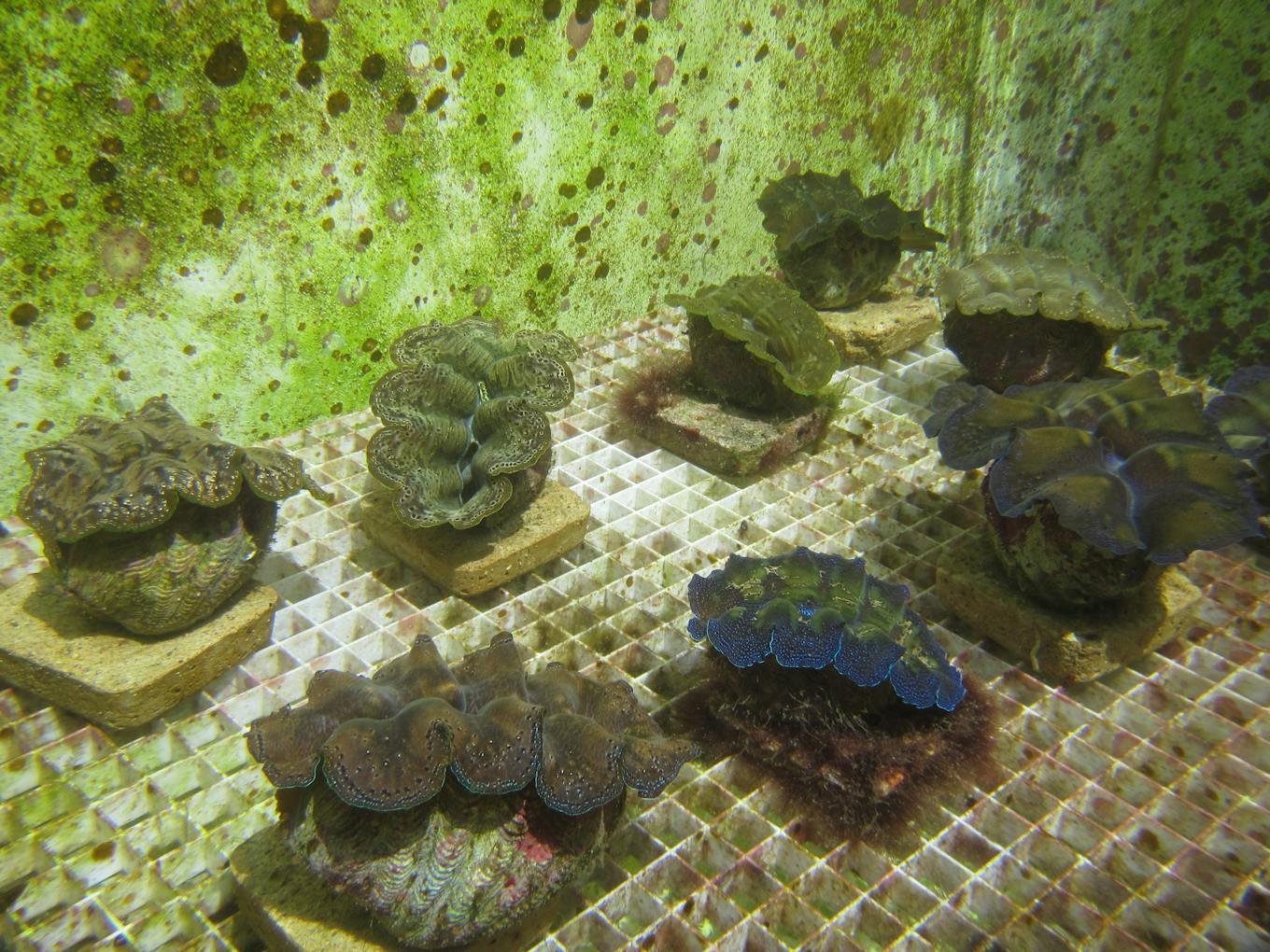
The boring giant clams (Tridacna crocea) are kept in aquaria tanks as broodstocks to be used for breeding in the lab. Prior to spawning these clams, they are supplemented with a microalgal diet to boost their health condition as the release of eggs or sperm is a highly energetic process. Image: Neo Mei Lin / Tropical Marine Science Institute.
5.45pm: The boat docks at the jetty and I start my hour-long commute back home to pick up my older daughter from childcare. On the way back, I check in with our live-in helper on the status of our youngest daughter’s day at school.
7.15pm: I will usually take a quick shower to refresh myself after a long day of work, and have dinner and spend time with my family.
8.00pm: Once a month, I will attend the IUCN Species Survival Commission (SSC) Marine Conservation Committee (MCC) meetings over Zoom with my international colleagues to discuss various marine conservation issues. By the invitation of the committee’s chair Dr Amanda Vincent, I joined the senior leadership group to support, connect and mobilise SSC expertise in marine species conservation. Our role in the MCC is to contribute our broad understanding to marine issues and be as influential as possible in conservation. I feel really honoured to be invited to serve on the committee in the coming quadrennium, knowing that I can make a difference by supporting other marine conservation workers through this committee.
9.30pm: After my online meetings, I check on my seven-month-old who is usually asleep by this time and then put my three-year-old to her bed. I usually read a story book to her, but today I show her the photos and videos of different marine animals that I had spotted on my fieldtrip earlier in the day. We talk about where they live and what they eat, and why mummy is studying them. Although she may not fully appreciate the meaning behind our conversation, I hope it will ignite a spark of interest for learning and appreciating nature.
10.30pm: I exit my daughter’s room and head into our study to finish up for the day. I go through my emails and mark them out for review later, check my schedule for the following day, and prepare a to-do list. If I still have some energy left, I will spend an hour working on some crafts or watch a drama series.
12.00am: Finally, bedtime.

